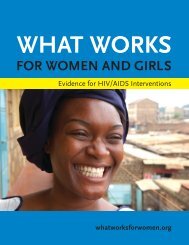Global Tuberculosis Report -- 2012.pdf
Global Tuberculosis Report -- 2012.pdf
Global Tuberculosis Report -- 2012.pdf
You also want an ePaper? Increase the reach of your titles
YUMPU automatically turns print PDFs into web optimized ePapers that Google loves.
This annex explains the methods that were used to produceestimates of the global burden of disease caused byTB (measured in terms of incidence, prevalence and mortality).It has nine major sections:● General approach. This section provides some backgroundinformation about the methods used to produceestimates of disease burden.● Definitions. This section defines TB incidence, prevalenceand mortality, the case fatality rate (CFR) andthe case notification rate. It also explains the regionsfor which estimates of disease burden are producedand sources of information on population estimates.● Estimates of TB mortality, 1990–2011. This sectionexplains the three methods used to estimate TB mortality,and the countries for which they were applied.Methods for estimating the number of HIV-associatedTB deaths and for disaggregation of TB mortality byage and sex are also described.● Estimates of TB incidence, 1990–2011. This sectionexplains the main methods used to estimate TB incidence,and the countries for which they were applied.Methods to estimate the prevalence of HIV amongincident TB cases are described.● Estimates of TB prevalence, 1990–2011. This sectionexplains the two methods used to estimate TBprevalence, and the countries for which they wereapplied.● Estimates of the number of cases of multidrugresistantTB (MDR-TB). This section explains howestimates of the proportion of notified cases of TB thathad MDR-TB in 2011 were produced and used to assessthe number of prevalent cases of MDR-TB in 2011.● Projections of TB incidence, prevalence and mortality.This section explains how projections up to2015 were produced.● Uncertainty framework. This section explains thegeneral approach to including uncertainty in all estimates.1. General approachEstimates of the burden of disease caused by TB (measuredin terms of incidence, prevalence and mortality)are produced annually by WHO using information gatheredthrough surveillance systems (case notifications anddeath registrations), special studies (including surveys ofthe prevalence of disease, mortality surveys and in-depthanalyses of surveillance data), expert opinion and consultationswith countries. Two recent publications provideup-to-date guidance about how TB incidence, prevalenceand mortality should be measured, 1 based on the workof the WHO <strong>Global</strong> Task Force on TB Impact Measurement.2 The methods used to estimate the burden of diseasewere updated in 2009 following 18 months of workby an expert group convened by the Task Force. Improvementsto methods included systematic documentation ofexpert opinion and how this has been used to produceestimates of disease burden, simplification of models, 3updates to parameter values based on the results of systematicreviews, much greater use of mortality data fromVR systems and systematic documentation of uncertainty(hence the uncertainty intervals shown on all of the estimatesof disease burden in this report).2. Definitions2.1 Incidence, prevalence, mortality, case fatalityrate, case notification rateIncidence is defined as the number of new and recurrent(relapse) episodes of TB (all forms) occurring in a givenyear. Recurrent episodes are defined as a new episode ofTB in people who have had TB in the past and for whomthere was bacteriological confirmation of cure and/ordocumentation that treatment was completed (Box 3.1,Chapter 3). In the remainder of this Annex, relapse casesare referred to as recurrent cases because the term is moreuseful when explaining the estimation of TB incidence.Recurrent cases may be true relapses or a new episodeof TB caused by reinfection. In current case definitions,both relapse cases and patients who require a change intreatment are called “retreatment cases”. However, peoplewith a continuing episode of TB that requires a treatmentchange are prevalent cases, not incident cases.Prevalence is defined as the number of TB cases (allforms) at a given point in time.Mortality from TB is defined as the number of deathscaused by TB in HIV-negative people, according to the latestrevision of the international classification of diseases(ICD-10). TB deaths among HIV-positive people are classifiedas HIV deaths in ICD-10. For this reason, estimatesof deaths from TB in HIV-positive people are presentedseparately from those in HIV-negative people.The case fatality rate is the risk of death from TB amongpeople with active TB disease. 4The case notification rate refers to new and recurrentepisodes of TB notified to WHO for a given year, expressedper 100 000 population. The case notification rate for newand recurrent TB is important in the estimation of TB1TB impact measurement: policy and recommendations for how toassess the epidemiological burden of TB and the impact of TB control.Geneva, World Health Organization, 2009 (Stop TB policypaper, no. 2; WHO/HTM/TB/2009.416). The policy paper isavailable on the Task Force’s web sitewww.who.int/tb/advisory_bodies/impact_measurement_taskforce2For further details, see the Task Force web site at:www.who.int/tb/advisory_bodies/impact_measurement_taskforce3For example, some parameter values are now estimated onlyat global level or for regions, rather than for each country individually.4Straetemans M et al. Assessing tuberculosis case fatality ratio:a meta-analysis. PLoS One. 2011, 6(6):e20755.GLOBAL TUBERCULOSIS REPORT 2012 93
















